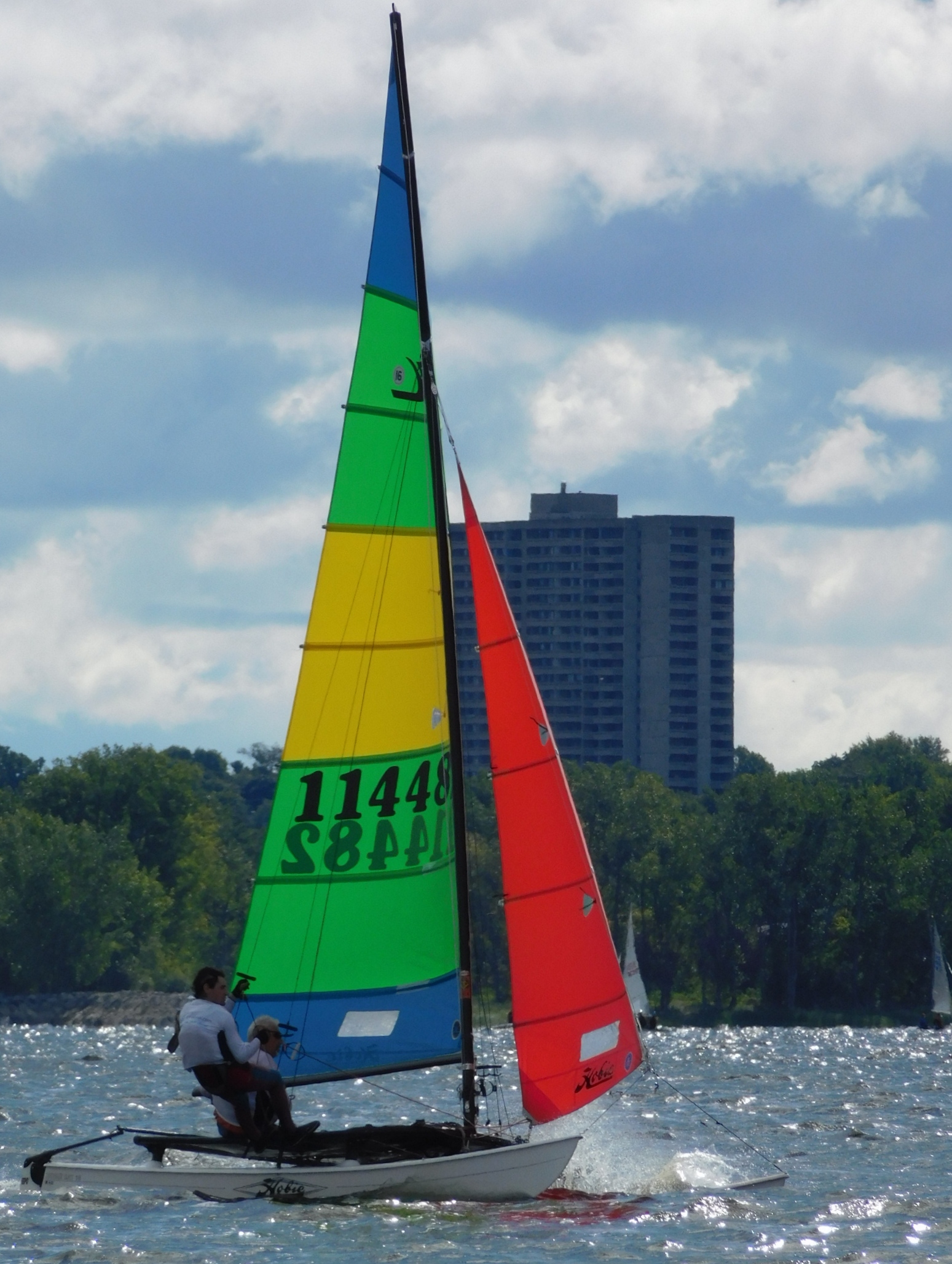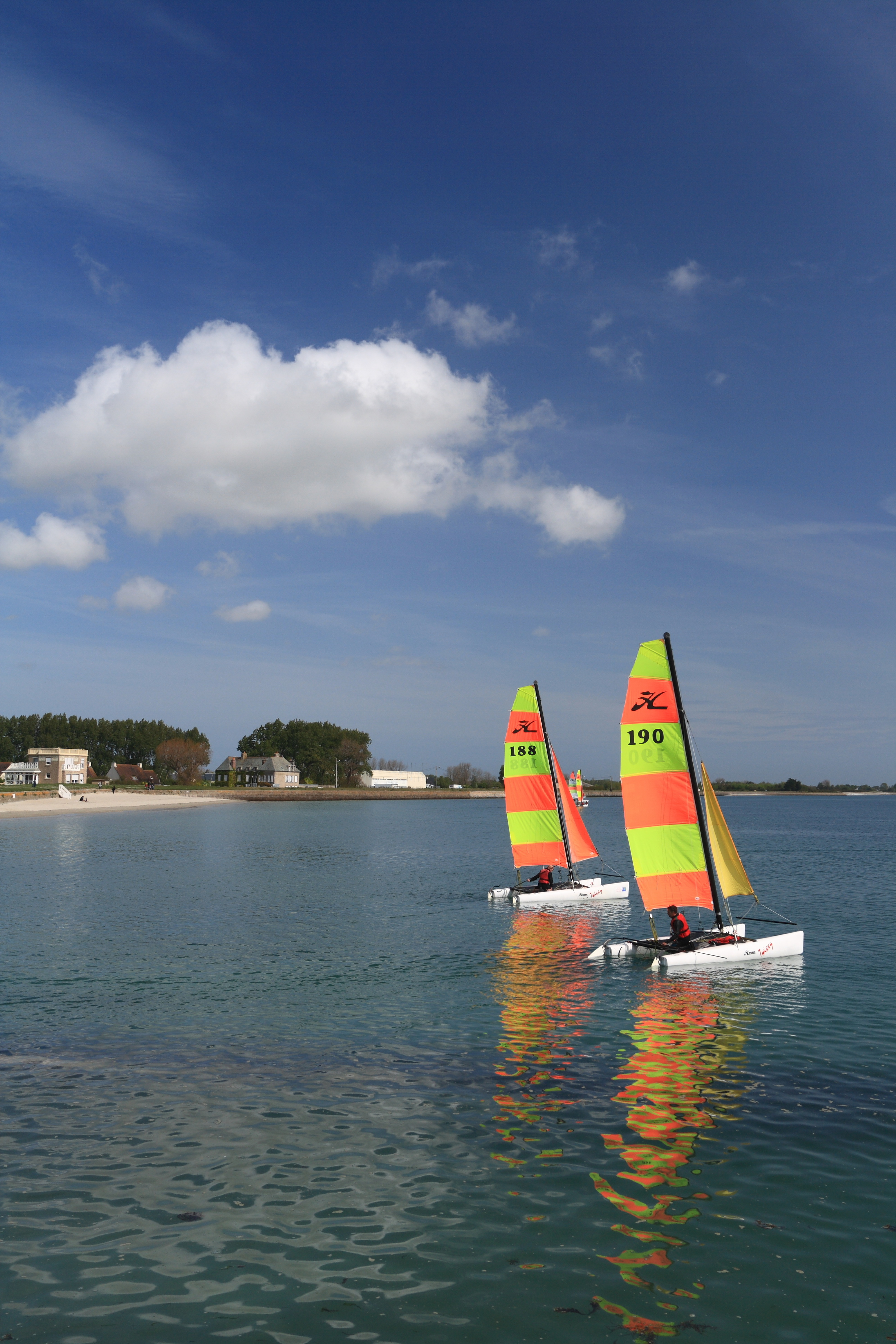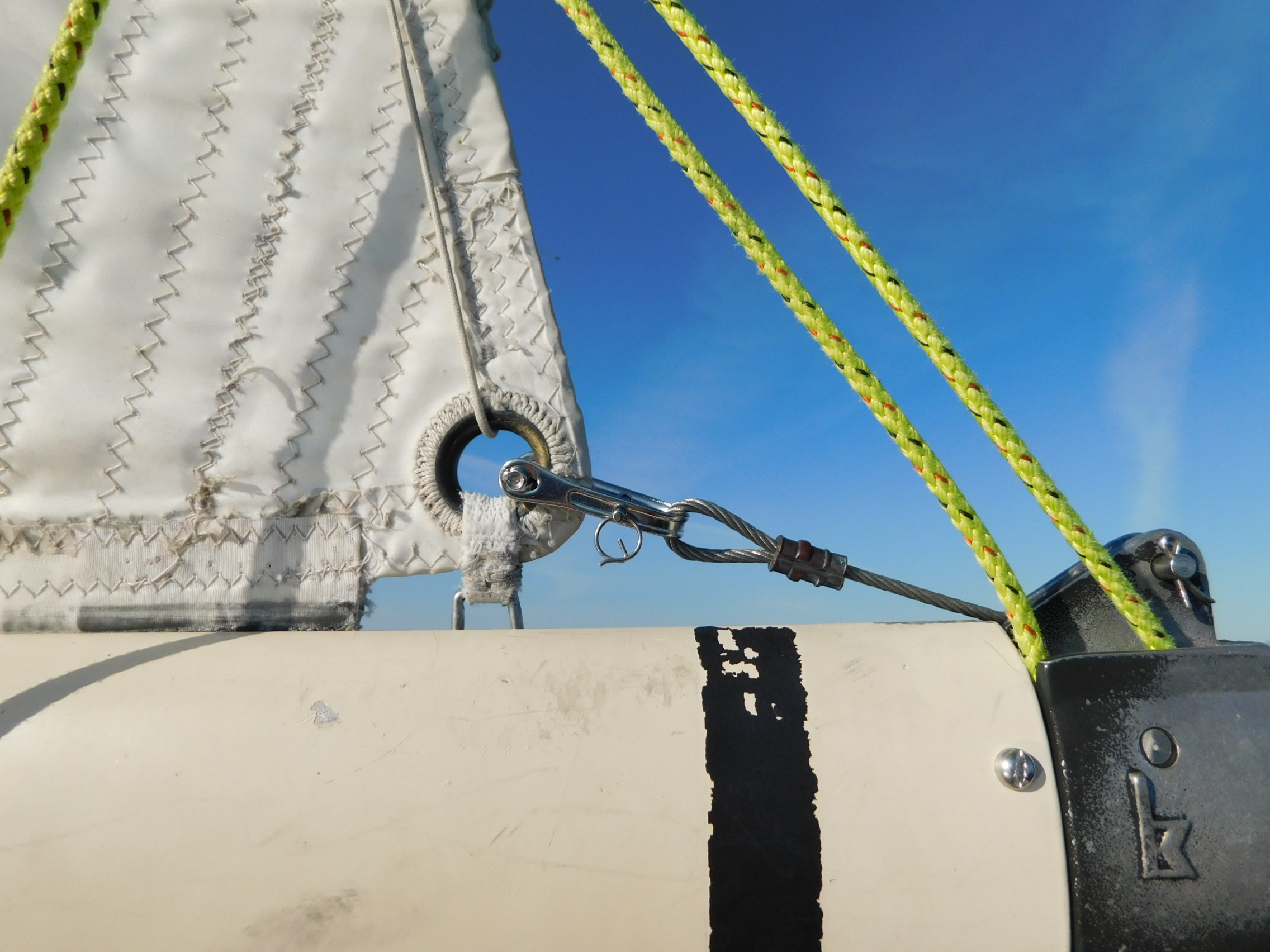|
Hobie Catamaran
The ISAF International Class Hobie 16 (H16) is a popular catamaran manufactured by the Hobie Cat Company for racing and day sailing. The craft was the driving force behind the popularization of beachcats and was recently inducted into the Sailing Hall Of Fame. Introduced in 1971, the Hobie 16 is the second largest boat fleet in existence with over 135,000 boats built to date. The boat is distinctly recognized for its asymmetric "banana" shaped hulls, designed to work without the need for daggerboards so the catamaran could be run up the beach without worry. The rudders kick up automatically by lifting up on the tiller crossbar. Design The Hobie 16 is manufactured in France by the Hobie Cat company, and by the Hobie Cat of America company in the United States. The Hobie 16 normally carries two sails, the mainsail and the jib. There is a kit to allow an H16 to fly a spinnaker but this is only class legal for youth racing. Each hull has two pylons (the forward ones are vent ... [...More Info...] [...Related Items...] OR: [Wikipedia] [Google] [Baidu] |
Hobie 14
The Hobie 14 is an American catamaran sailing dinghy that was designed by Hobie Alter and first built in 1967.Sherwood, Richard M.: ''A Field Guide to Sailboats of North America, Second Edition'', pages 38-39. Houghton Mifflin Company, 1994. The design was developed into the Hobie 16 in 1971. Production The Hobie 14 was the initial design produced by Hobie Cat and led to a large family of similar boats that have been produced in numbers exceeding 200,000. The design was built by Hobie Cat in the United States from 1967 until 2004 and in Europe until the late 2000s, but it is now out of production. Design The Hobie 14 is a recreational sailboat, built predominantly of fiberglass over a foam core. In its base model it has a fully battened catboat rig with a rotating mast and aluminum spars. A jib can be added to make it a fractional sloop rig and a trapeze is optional. The asymmetrical hulls have spooned raked stems, vertical transoms and dual transom-hung rudders controlle ... [...More Info...] [...Related Items...] OR: [Wikipedia] [Google] [Baidu] |
Crossmember
A crossmember is a structural section that is transverse to the main structure. In the automotive industry, the term typically refers to a component, usually of steel, usually boxed, that is bolted across the underside of a monocoque / unibody motor vehicle, to support the internal combustion engine and / or transmission. For the suspension of any car to operate as it should, for proper handling, and to keep the body panels in alignment, the frame has to be strong enough to cope with the loads applied to it. It must not deflect, and it has to have enough torsional strength to resist twisting. A "K" member is a crossmember in a vehicle with a longitudinally-mounted engine, contains the engine mounts.cross member of frame is I section. In early Ford vehicles An "X" crossmember can usually be found on the frames of vintage. Although it used more substantial rails than a Model T The Ford Model T is an automobile that was produced by Ford Motor Company from October 1, 1908, t ... [...More Info...] [...Related Items...] OR: [Wikipedia] [Google] [Baidu] |
Catamarans
A Formula 16 beachable catamaran Powered catamaran passenger ferry at Salem, Massachusetts, United States A catamaran () (informally, a "cat") is a multi-hulled watercraft featuring two parallel hulls of equal size. It is a geometry-stabilized craft, deriving its stability from its wide beam, rather than from a ballasted keel as with a monohull boat. Catamarans typically have less hull volume, smaller displacement, and shallower draft (draught) than monohulls of comparable length. The two hulls combined also often have a smaller hydrodynamic resistance than comparable monohulls, requiring less propulsive power from either sails or motors. The catamaran's wider stance on the water can reduce both heeling and wave-induced motion, as compared with a monohull, and can give reduced wakes. Catamarans were invented by the Austronesian peoples which enabled their expansion to the islands of the Indian and Pacific Oceans. Catamarans range in size from small sailing or rowing ve ... [...More Info...] [...Related Items...] OR: [Wikipedia] [Google] [Baidu] |
Classes Of World Sailing
Class or The Class may refer to: Common uses not otherwise categorized * Class (biology), a taxonomic rank * Class (knowledge representation), a collection of individuals or objects * Class (philosophy), an analytical concept used differently from such group phenomena as "types" or "kinds" * Class (set theory), a collection of sets that can be unambiguously defined by a property that all its members share * Hazard class, a dangerous goods classification * Social class, the hierarchical arrangement of individuals in society, usually defined by wealth and occupation * Working class, can be defined by rank, income or collar Arts, entertainment, and media * "The Class" (song), 1959 Chubby Checker song *Character class in role-playing games and other genres *Class 95 (radio station), a Singaporean radio channel Films * ''Class'' (film), 1983 American film * ''The Class'' (2007 film), 2007 Estonian film * ''The Class'' (2008 film), 2008 film (''Entre les murs'') Television * ''Class ... [...More Info...] [...Related Items...] OR: [Wikipedia] [Google] [Baidu] |
Hobie 16
The ISAF International Class Hobie 16 (H16) is a popular catamaran manufactured by the Hobie Cat Company for racing and day sailing. The craft was the driving force behind the popularization of beachcats and was recently inducted into the Sailing Hall Of Fame. Introduced in 1971, the Hobie 16 is the second largest boat fleet in existence with over 135,000 boats built to date. The boat is distinctly recognized for its asymmetric "banana" shaped hulls, designed to work without the need for daggerboards so the catamaran could be run up the beach without worry. The rudders kick up automatically by lifting up on the tiller crossbar. Design The Hobie 16 is manufactured in France by the Hobie Cat company, and by the Hobie Cat of America company in the United States. The Hobie 16 normally carries two sails, the mainsail and the jib. There is a kit to allow an H16 to fly a spinnaker but this is only class legal for youth racing. Each hull has two pylons (the forward ones are ven ... [...More Info...] [...Related Items...] OR: [Wikipedia] [Google] [Baidu] |
Limit Of Positive Stability
In sailing, the limit of positive stability (LPS) or angle of vanishing stability (AVS) is the angle from the vertical at which a boat will no longer stay upright but will capsize, becoming :wikt:inverted, inverted, or Turtling (sailing), turtled. For example, if a boat with an LPS of 120 Degree (angle), degrees rolls past this point, i.e. its Mast (sailing), mast is already at an angle of 30 degrees below the water, it will continue to roll and be completely upside down in the water. Except for Dinghy sailing, dinghy sailboats and multihulls, most larger sailboats (monohull keelboats) have lead or other heavy materials in their keel at the bottom of their hulls to keep them from capsizing or turtling. The LPS was a part of the Offshore Racing Rules and is used to measure how Ship stability, stable or seaworthy a sailboat is. The modern offshore racing rules published by the International Sailing Federation may also use the measurement. See also *Angle of loll *Capsizing * ... [...More Info...] [...Related Items...] OR: [Wikipedia] [Google] [Baidu] |
Hobie Cat
Hobie Cat is a company that manufactures sailing catamarans, surfboards, sailboats, kayaks, stand-up paddle boards, and pedalboards as the Hobie Cat Company. It was founded in 1961 by Hobart Alter, who originally manufactured surfboards. Its line of products has included more than twenty sailing craft, plus a variety of other watercraft. History Hobie Cat was founded by Hobart Alter. Initially a surfboard manufacturer in the late 1950s, in 1961 Alter's focus changed to designing an easily beached fiberglass catamaran. The impetus of this shift is attributed to a 1961 boat show in Anaheim, CA where Alter sold surfboards adjacent to the designer of the 1961 Aqua Cat 12 sailboat, which featured lightweight fiberglass hulls with an aluminium tube structure supporting a trampoline style deck for seating. Following the 1961 boat show, Alter contacted Arthur "Art" Javes to tell him he was also entering the fledgling catamaran market. The first production Hobie Cat was launched on July ... [...More Info...] [...Related Items...] OR: [Wikipedia] [Google] [Baidu] |
Hobart "Hobie" Alter
Hobart "Hobie" Alter (October 31, 1933 – March 29, 2014) was an American surf and sailing entrepreneur and pioneer, creator of the Hobie Cat catamarans, and founder of the Hobie company. Biography Hobie Alter will be remembered for creating the process of the foam-and-fiberglass surfboard and his subsequent creation of the Hobie Cat catamaran sailing boat line. His label, Hobie, is one of the top-selling surfboard brands of all time. He is also the creator of the Hobie 33 ultralight-displacement sailboat and a mass-produced radio-controlled glider, the Hobie Hawk. During summer vacation 1950 Alter began by building 9-foot balsawood surfboards for his friends. He asked his dad to pull the Desoto out of the family's Laguna Beach, California, garage, and converted it into a wood shop for his hobby. Alter‘s hobby became a business and in discussing the future with friends as a young man "Hobie" declared that he wanted to make a living without having to wear hard-soled shoe ... [...More Info...] [...Related Items...] OR: [Wikipedia] [Google] [Baidu] |
List Of Multihulls
Types * catamaran = two symmetric hulls * proa = two asymmetric hulls, reverse-shunting (interchangeable bow/stern) * trimaran = three hulls * quadrimaran = four hulls * pentamaran = five hulls Pre-modern Austronesian * ʻalia * Amatasi * Balangay * Basnigan * Baurua * Camakau * Catamaran * Drua * Jukung * Kaep * Kalia * Karakoa * Kora kora * Lakana * Lakatoi * Ngalawa * Oruwa * Outrigger canoe * Pahi * Paraw * Paruwa * Proa * Sandeq * Takia * Tepukei * Tipairua * Tongiaki * Va'a-tele * Vaka katea * Vinta * Wa * Yathra doni Pre-modern Western * ''Tessarakonteres'' and '' Thalamegos'' (3rd century BC) * '' Simon & Jude'' or '' Invention I'' (1662) * '' Invention II'' (1662) * ''Experiment'' (1664) * '' St. Michael the Archangel'' (1684) * ''Experiment'' (1786) * ''Taurus'' (1790s) 19th century *''Jersey'' (1812) *''York'' (1813) *''Nassau'' (1814) *''Steam Battery'' (1815) *'' Double Trouble'' (1820) *'' Castaliâ'' (1874) *''Amaryllis'' (1876) *'' Calais-Douvr ... [...More Info...] [...Related Items...] OR: [Wikipedia] [Google] [Baidu] |
Outhaul
An outhaul is a control line found on a sailboat. It is an element of the running rigging, used to attach the mainsail Parts of a sail#Corners, clew to the boom (sailing), boom and tensions the Sail components#Edges, foot of the sail. It commonly uses a Block (sailing), block at the boom end and a Cleat (nautical), cleat on the boom, closer to the mast, to secure the line. The outhaul is loosened to provide a fuller camber or tightened to give the sail foot a flatter camber. Depending on the wind, this will increase or decrease boat speed. Naval architect, Sailboat designer and sailing theorist, Frank Bethwaite, recommended that the outhaul, along with the other sail controls on a Sailing (sport), racing sailboat, should be knotted and the boom marked with the settings for different wind speeds. References {{Sail Types Sailing rigs and rigging ... [...More Info...] [...Related Items...] OR: [Wikipedia] [Google] [Baidu] |
Downhaul
The downhaul is a line which is part of the rigging on a sailboat; it applies downward force on a spar or sail. The most common downhaul on a modern sailboat is attached to the spinnaker pole, though this may be referred to as the foreguy in some rigging nomenclature. The term is also commonly applied to the cunningham on the mainsail. In a windsurfing rig, the downhaul is the primary load-bearing line which controls the sail's shape. Modern windsurfing sails incorporate a sleeve for the mast, and therefore do not have a halyard In sailing, a halyard or halliard is a line (rope) that is used to hoist a ladder, sail, flag or yard. The term ''halyard'' comes from the phrase "to haul yards". Halyards, like most other parts of the running rigging, were classically made of ... which tensions the top of the sail. The downhaul is tensioned early in the rigging process and is generally not adjustable on the water, and is therefore rather different in use than the downhaul on a sailb ... [...More Info...] [...Related Items...] OR: [Wikipedia] [Google] [Baidu] |
Sheet (sailing)
In sailing, a sheet is a line (rope, cable or chain) used to control the movable corner(s) (clews) of a sail. Terminology In nautical usage the term "sheet" is applied to a line or chain attached to the lower corners of a sail for the purpose of extension or change of direction. The connection in derivation with the root "shoot" is more clearly seen in "sheet-anchor", one that is kept in reserve, to be "shot" in case of emergency. Fore-and-aft rigs Fore-and-aft rigs comprise the vast majority of sailing vessels in use today, including effectively all dinghies and yachts. The sheet on a fore-and-aft sail controls the angle of the sail to the wind, and should be adjusted to keep the sail just filled. Most smaller boats use the Bermuda rig, which has two or three sets of sheets: * The mainsheet is attached to the boom, and is used to control the mainsail. In a rig with no boom on the mainsail, the mainsheet would attach directly to the mainsail clew. A mainsheet is a line c ... [...More Info...] [...Related Items...] OR: [Wikipedia] [Google] [Baidu] |






